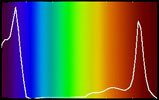
What Is It?
And Where Does It Come From?

Chlorophyll (also known as Chlorella and Wheat Grass) is chemical relative of vitamin B12 and is found in the leaves of plants. Chlorophyll allows plants to use sunlight for energy and it gives plant leaves their green color.
 |
Changing Colors: Within the photosynthetic cells of plants the chlorophyll is in the chloroplastsâ€"small, roundish, dense protoplasmic bodies that contain the grana, or disks, where the chlorophyll molecules are located. Chlorophyll absorbs light in the red and blue-violet portions of the visible spectrum; the green portion is not absorbed and, reflected, gives chlorophyll its characteristic color. Within the photosynthetic cells of plants the chlorophyll is in the chloroplastsâ€"small, roundish, dense protoplasmic bodies that contain the grana, or disks, where the chlorophyll molecules are located. Chlorophyll absorbs light in the red and blue-violet portions of the visible spectrum; the green portion is not absorbed and, reflected, gives chlorophyll its characteristic color. Chlorophyll tends to mask the presence of colors in plants from other substances, such as the carotenoids. When the amount of chlorophyll decreases, the other colors become apparent. This effect can be seen most dramatically every autumn when the leaves of trees "turn color." |
 |
 |
||
Many people believe that Chlorophyll contains chlorine, but this is a myth. There is no chlorine in chlorophyll - the term Chloro derives from the Greek and means "yellowish green."
Dietary sources of chlorophyll include dark green leafy vegetables like spinach and romaine lettuce, and vegetables like broccoli and asparagus.

What Does It Do?
And What Scientific Studies Give Evidence To Support This?
Plants use chlorophyll to derive energy from sunlight through a complex series of chemical reactions, and animals need chlorophyll to help digest food and absorb minerals from their diet.
Chlorophyll is a powerful antioxidant3 and has been used as a system detoxifier. It may purify the blood, heal tissues and prevent cancer by scavenging for cancerous free-radicals. 1,2 It may also help the liver build red blood cells.
In addition to its cancer fighting abilities, chlorophyll has been used to destroy harmful bacteria and is routinely added to chewing gums for its ability to prevent bad breath.
Chlorophyll has long been known to alleviate gastric distress, including indigestion and constipation.
| RELATED ARTICLE | ||
|

Who Needs It?
And What Are Some Symptoms Of Deficiency?
Everyone can benefit from chlorophyll supplementation.
You are susceptible to pollution and the stresses of fast paced life if you live in a major city. Chlorophyll may scavenge your system for harmful free radicals and protect you from the damage that they can do to your muscles and cells.
What's more, if you have a tissue injury that is healing, chlorophyll may speed healing because of its ability to kill bacteria. In this way, chlorophyll may play a role in preventing infections.
If your immune system is depressed because of ageing or medical history, chlorophyll may help to boost its function. Maintaining healthy muscles is important for immune-system health. Free radicals and bacteria can damage crucial muscle mass, leaving you at a risk for infection and illness.
Its ability to stimulate red blood cell production may aid in the building of muscle tissue, and chlorophyll is thus ideal for the hard training athlete. Anabolic steroids act to increase protein synthesis via an increase in red blood cell production, and this may be responsible for increases in muscle tissue.
Chlorophyll's ability to protect the immune system make it an ideal supplement pre and post workout. Muscle tissue is most vulnerable to exercise-induced oxidative damage post-workout, and muscular repair cannot occur in the presence of free radicals. As a free antioxidant, chlorophyll will scavenge your system for free-radicals, ensuring that you grow as much as possible from your workout.

How Much Should Be Taken?
And Are There Any Side Effects?
Strictly adhere to label directions.
No side-effects have been reported in anecdote or scientific literature.
References:
- Gruskin B. Chlorophyll-its therapeutic place in acute and suppurative disease. Am J Surg 1940;49:49-56.
- Hayatsu H, Negishi T, Arimoto S, et al. Porphyrins as potential inhibitors against exposure to carcinogens and mutagens. Mutat Res 1993;290:79-85.
- Rudolph C. The therapeutic value of chlorophyll. Clin Med Surg 1930;37:119-21.

